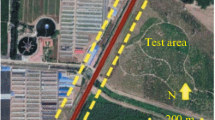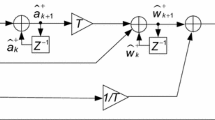Abstract
We propose a novel dynamic model of Doppler frequency and phase, called as a polynomial prediction model (PPM), where a constant acceleration or deceleration motion law described by a polynomial is assumed, then a new self-validating optimal filtering algorithm, based on the proposed model and the unscented Kalman filter (UKF), is developed for the frequency and phase estimates of the Doppler signal in a variable acceleration and/or deceleration motion scenario. The analytical results show that the proposed algorithm can effectively track Doppler frequency and phase whatever the maneuvering motion between the transceivers is. The analytical results are verified by the simulations and the experimental results of a real live GPS receiver, which show that the proposed algorithm is superior to most of those reported in the literature when the received signal power is over a guaranteed value in the case of GPS.
Similar content being viewed by others
References
Proakis J. G. (1995) Digital communications[M] (3rd ed.). McGrawHill, New York
Kaplan E. D., Hegatry C. J. (2006) Understanding GPS principles and applications (2nd ed.). Artech House, Norwood, MA
Bao-Yen Tsui J. (2005) Fundamentals of global positioning system receivers-a software approach (2nd ed.). Wiley, Hoboken, New Jersey
Borre K., Akos D.M., Bertelsen N. (2006) A software-defined GPS and Galileo receiver. Birkhauser, Boston
Vilnrotter V. A., Hinedi S., Kumar R. (1989) Frequency estimation techniques for high dynamic rrajectories. IEEE Transactions on Aerospace and Electronic Systems 25: 559–577
Kay S. M. (1993) Fundamentals of statistical signal processing volume I: estimation theory. Prentice Hall, New Jersey
Julier, S. J., & Uhlmann, J. K. (1997). A new extension of the Kalman filter to nonlinear systems, the 11th international symposium on aerospace/defence sensing, simulation and controls. Orlando, Florida, Vol. Multi Sensor Fusion, Tracking and Resource Management II.
van der Merwe, R., Doucet, A., & de Freitas, N. (August 2000). The unscented particle filter. Oregon Graduate Institute.
Julier S. J., Uhlman J. K. (2004) Unscented filtering and nonlinear estimation. Proceedings of the IEEE 92: 401–422
Arulampalam M.S., Maskell S., Gordon N. (2002) A tutorial on particle filters for online nonlinear non-Gaussian Bayesian tracking. IEEE Transactions on Signal Processing 50: 174–188
Li X. R., Jilkov V. P. (2003) Survey of maneuvering target tracking. Part I: dynamic models. IEEE Transactions on Aerospace and Electronic Systems 39: 1333–1364
Bar-Shalom Y., Li X. R., Kirubarajan T. (2001) Estimation with applications to tracking and navigation: theory, algorithm, and software. Wiley, New York
Heinonen P., Neuvo Y. (1998) FIR-median hybrid filters with predictive FIR substructures[J]. IEEE Transactions on Acousitics, Speech and Signal Processing 36: 892–899
Valiviita S., Ovaska S. J., Vainio O. (1999) Polynomial predictive filtering in control instrumentation: a review. IEEE Transactions on Industrial Electronics 46: 876–888
HartiKainen, J., Sarkka, S. (2008). Optimal filtering with Kalman filters and smoothers—a Manual for Matlab toolbox EKU/UKF.
Wu Y., Hu D., Wu M., Hu X. (2005) Unscented Kalmen filtering for additive noise case: augmented versus nonaugmented. IEEE Signal Processing Letters 12: 357–360
Weisstein, E. W. Weierstrass approximation theorem. From MathWorld—A Wolfram Web Resource. http://mathworld.wolfram.com/WeierstrassApproximationTheorem.html.
Melrra R. K. (1970) On the identification of variance and adaptive Kalman filtering. IEEE Transactions on Automatic Control 15: 175–184
Parzen E. (1961) An approach to time series analysis. The Annals of Mathematical Statistics 32: 951–989
Fitzgerald R. J. (1971) Divergence of the Kalman filter. IEEE Transactions on Automation Control 16: 736–747
Best R. E. (1999) Phase-locked loop design, simulation and application (4th ed.). McGraw-Hill, Columbus, OH
Author information
Authors and Affiliations
Corresponding author
Rights and permissions
About this article
Cite this article
Zhao, J., Yin, J.J., Zhang, J.Q. et al. A Novel Doppler Frequency Dynamic Model with Its Applications. Wireless Pers Commun 66, 275–289 (2012). https://doi.org/10.1007/s11277-011-0338-z
Published:
Issue Date:
DOI: https://doi.org/10.1007/s11277-011-0338-z




